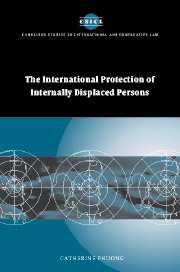Book contents
- Frontmatter
- Contents
- Acknowledgments
- Table of cases
- Table of treaties and other international documents
- List of abbreviations
- Introduction
- 1 Internally displaced persons and refugees: conceptual differences and similarities
- 2 The legal protection of internally displaced persons
- 3 The institutional framework of protection for the internally displaced
- 4 Protection strategies for the internally displaced
- 5 Case study: internal displacement in Bosnia and Herzegovina
- 6 Reconceiving sovereignty and intervention
- Conclusions
- Annex 1: The Guiding Principles on Internal Displacement
- Bibliography
- Index
- CAMBRIDGE STUDIES IN INTERNATIONAL AND COMPARATIVE LAW
1 - Internally displaced persons and refugees: conceptual differences and similarities
Published online by Cambridge University Press: 17 July 2009
- Frontmatter
- Contents
- Acknowledgments
- Table of cases
- Table of treaties and other international documents
- List of abbreviations
- Introduction
- 1 Internally displaced persons and refugees: conceptual differences and similarities
- 2 The legal protection of internally displaced persons
- 3 The institutional framework of protection for the internally displaced
- 4 Protection strategies for the internally displaced
- 5 Case study: internal displacement in Bosnia and Herzegovina
- 6 Reconceiving sovereignty and intervention
- Conclusions
- Annex 1: The Guiding Principles on Internal Displacement
- Bibliography
- Index
- CAMBRIDGE STUDIES IN INTERNATIONAL AND COMPARATIVE LAW
Summary
Refugees and the internally displaced are categories of persons which share many similarities such that people in both categories often find themselves in the same material conditions. For historical, political and legal reasons, it has been judged appropriate not to include internally displaced persons in the refugee definition contained in the 1951 Convention. There has been confusion about the concept of internally displaced persons and it has been argued that the internally displaced should be treated as refugees because they are essentially the same. This chapter seeks to determine whether there is a justification for the exclusion of internally displaced persons from the protection and rights afforded to refugees. It calls for a reconceptualisation of the problem of internal displacement which needs to be discussed in a wider human rights context.
For most people, as evident from the media coverage, the term ‘refugee’ refers to anyone who has been forced to leave his home. Whether the person has left the country or not is seen as irrelevant. The legal terminology is however more precise, as it requires the refugee to be outside his or her country of origin because of a fear of persecution. Internally displaced persons have also been referred to as ‘internal refugees’ which is an oxymoron. This creates confusion by blurring the distinction between refugees and internally displaced persons, which, as the chapter argues, should be maintained.
The expression ‘internally displaced persons’ is of more recent usage. Until the late 1980s, there was no such standard term.
- Type
- Chapter
- Information
- Publisher: Cambridge University PressPrint publication year: 2005



